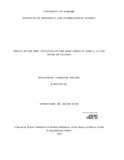| dc.contributor.author | Nelima, Murandafu C | |
| dc.date.accessioned | 2013-05-09T12:40:22Z | |
| dc.date.available | 2013-05-09T12:40:22Z | |
| dc.date.issued | 2007 | |
| dc.identifier.uri | http://erepository.uonbi.ac.ke:8080/xmlui/handle/123456789/20882 | |
| dc.description.abstract | Unsustainable debt has for over two decades undermined investment and growth in low
income countries in Africa. This has posed a serious threat to the efforts of these countries
to address the problem of absolute poverty. The case of Uganda is typical of the
experience of many other countries in Sub-Saharan Africa. A number of initiatives have
been fronted by International Financial Institutions to deliver Africa from the debt trap, the
latest being the Highly Indebted Poor Countries (HIPC) Initiative.
This paper presents a country case study of the impact of the HIPC initiative on the debt
crisis in Africa. The paper chooses to study Uganda - a country termed the star pupil of
the IMF and World Bank Reforms. Uganda entered the HIPC process in 1997 and
received debt relief from both the first and enhanced HIPC debt relief in April 1998 and
April 2000 respectively. We discuss the sources of external debt in Uganda, the
magnitude of the debt burden and the impact of the HIPC debt relief measures on Uganda's
socio-economy.
The study establishes that while some positive effects have been experienced by Uganda
after receiving HIPC's debt relief, a lot more needs to be done by all stakeholders to hasten
the Initiatives pace towards achieving and maximizing its objective of ensuring debt
sustainability. | en |
| dc.description.sponsorship | The University of Nairobi | en |
| dc.language.iso | en | en |
| dc.subject | Impact of the HIPC initiative on the debt crisis in Africa | en |
| dc.subject | Uganda | en |
| dc.title | Impact of the HIPC Initiative on the Debt Crisis in Africa: a Case Study of Uganda | en |
| dc.type | Thesis | en |
| local.publisher | International relations | en |

